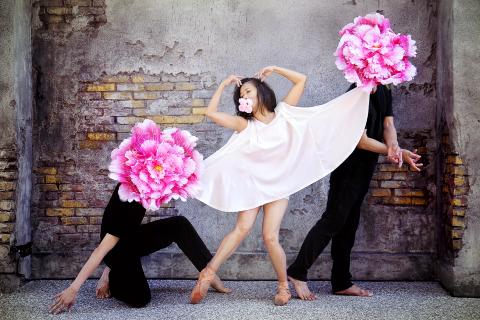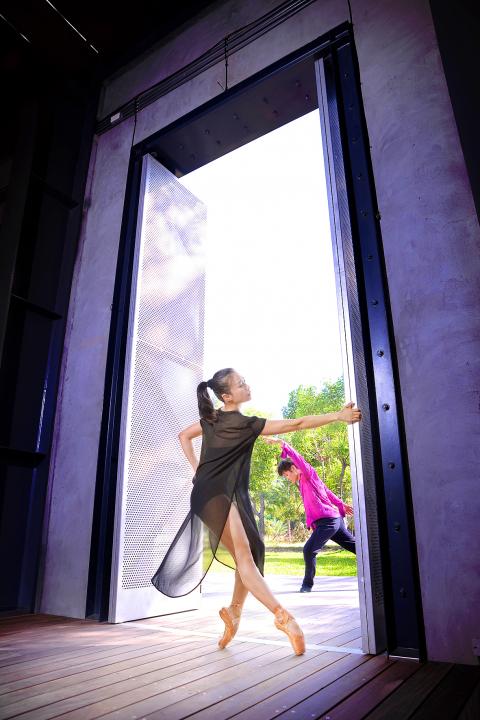Kaohsiung City Ballet (KCB, 高雄城市芭蕾舞團) founder Chang Hsiu-ru (張秀如) has an enviable record as a mentor and cultivator of both dancers and choreographers over her decades-long career, having marked 40 years as a dance teacher last year, while her company is now in its 23rd year.
She is bringing her best dancers to Taipei tomorrow for the start of the company’s annual Dance Shoe (點子鞋) production, with the three shows at the Experimental Theater at the start of a three-city tour.
The Dance Shoe productions are aimed at not only providing KCB members with more performing opportunities and the chance to dance under a variety of choreographers, but with giving choreographers born or working in southern Taiwan a platform for their creativity. It had done that and more. Since the first show in 2003, a total of 32 choreographers have created 71 works for the company.

Photo Courtesy of Kaohsiung City Ballet
Several now work with other troupes or have founded their own, such as former KCB dancer Yeh Ming-hwa (葉名樺), whose Nordic was performed at the Songshan Cultural and Creative Park at the beginning of last month, and who has been collaborating with Horse (驫舞劇場), and Benson Tsai (蔡博丞), whose created more than half-a-dozen works for Dance Shoe shows, founded his B.DANCE (丞舞製作團隊) in 2014 and last year picked up three choreography awards at dance festivals in Europe.
This year’s program features five works by choreographers that have been frequent contributors to previous editions. Wang Wei-ming (王維銘), a former Cloud Gate Dance Theatre (雲門舞集) dancer who teaches at Shu-Te University in Kaohsiung, and Wang Kuo-chuan (王國權), who spent 20 years working as a dancer in Europe before returning home, are probably the best known. The other three are Chang Ya-ting (張雅婷); Lai Hung-chung (賴翃中) and Dai Ting-ru (戴鼎如).
None of the pieces have been given “official” English titles, so the translations were worked out after some back and forth between the newspaper’s translation team and the company.

Photo Courtesy of Kaohsiung City Ballet
Wang Wei-ming’s piece The Stories They Told (她們在說故事) is set on five dancers and he said that he “stepped aside” in the creation of this piece, functioning more as an observer or co-author and letting the dancers have more of a hand in crafting the work.
Wang Kuo-chuan took Spanish flamenco as the starting point for his new work, Fragments of Madrid (馬德里的片段), a story about a wandering gypsy in which he will partner Ally Yeh (葉麗娟). He is the only choreographer who is also performing in the show.
Chang Ya-ting and Lai are both graduates of Taipei National University of the Arts (國立台北藝術大學) dance department, but their pieces show very different styles and outlooks.
Chang Ya-ting’s Murmurs (喃喃) features four dancers and two rather large flower heads. The piece was inspired by the way humans often mutter to themselves — about things they notice, questions they have or the way they are feelings — seemingly innocuous moments, but ones that are not forgotten and that sometimes bloom into something more consequential.
Lai’s duet for a man and a woman is entitled Grim Winter (凜凜) and centers on the emptiness and chill or winter and the hopes of the coming of spring.
Dai Ting-ru also created a duet, Waiting (從你的全世界路過), about life or the world passing a person by as they wait for something to happen.
After this weekend’s shows in Taipei, the company will return home to perform at the Kaohsiung Cultural Center’s Chihteh Hall next weekend and at the Tainan Municipal Cultural Center on Jan. 30.

April 14 to April 20 In March 1947, Sising Katadrepan urged the government to drop the “high mountain people” (高山族) designation for Indigenous Taiwanese and refer to them as “Taiwan people” (台灣族). He considered the term derogatory, arguing that it made them sound like animals. The Taiwan Provincial Government agreed to stop using the term, stating that Indigenous Taiwanese suffered all sorts of discrimination and oppression under the Japanese and were forced to live in the mountains as outsiders to society. Now, under the new regime, they would be seen as equals, thus they should be henceforth

Last week, the the National Immigration Agency (NIA) told the legislature that more than 10,000 naturalized Taiwanese citizens from the People’s Republic of China (PRC) risked having their citizenship revoked if they failed to provide proof that they had renounced their Chinese household registration within the next three months. Renunciation is required under the Act Governing Relations Between the People of the Taiwan Area and the Mainland Area (臺灣地區與大陸地區人民關係條例), as amended in 2004, though it was only a legal requirement after 2000. Prior to that, it had been only an administrative requirement since the Nationality Act (國籍法) was established in

With over 80 works on display, this is Louise Bourgeois’ first solo show in Taiwan. Visitors are invited to traverse her world of love and hate, vengeance and acceptance, trauma and reconciliation. Dominating the entrance, the nine-foot-tall Crouching Spider (2003) greets visitors. The creature looms behind the glass facade, symbolic protector and gatekeeper to the intimate journey ahead. Bourgeois, best known for her giant spider sculptures, is one of the most influential artist of the twentieth century. Blending vulnerability and defiance through themes of sexuality, trauma and identity, her work reshaped the landscape of contemporary art with fearless honesty. “People are influenced by

The remains of this Japanese-era trail designed to protect the camphor industry make for a scenic day-hike, a fascinating overnight hike or a challenging multi-day adventure Maolin District (茂林) in Kaohsiung is well known for beautiful roadside scenery, waterfalls, the annual butterfly migration and indigenous culture. A lesser known but worthwhile destination here lies along the very top of the valley: the Liugui Security Path (六龜警備道). This relic of the Japanese era once isolated the Maolin valley from the outside world but now serves to draw tourists in. The path originally ran for about 50km, but not all of this trail is still easily walkable. The nicest section for a simple day hike is the heavily trafficked southern section above Maolin and Wanshan (萬山) villages. Remains of